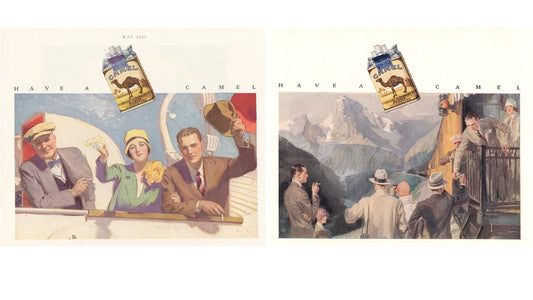
Nearly forgotten Art Deco artist’s ties to historic Versailles Hotel Miami Beach and Norman Rockwell
Share
Do you know of McClelland Barclay? He lived and worked as an artist of some renown in the Art Deco era. He studied art and shared accommodations with Norman Rockwell in the early 20th century. Turns out, Barclay was also connected to two historic Art Deco buildings. One is in Florida, the other in New York.

If you love Florida’s Art Deco Streamline architecture, you might know the Versailles Hotel and its architect, Roy F. France (1888-1972). It was Barclay who illustrated this wonderful view of the swimming pool and beach from a room in the historic Versailles Hotel on Collins Avenue in Miami Beach.
If you have never heard of McClelland Barclay, you are not alone. As the author of the first-ever illustrated biography, McClelland Barclay: Painter of Beautiful Women and More, I want to put Barclay back on the Art Deco artists' map.
Postcards for Preservationists
The Miami Design Preservation League used, but did not credit this art or artist in their report on the Versailles hotel. I found numerous postcards used to identify historic architecture by the City of Miami Beach. The city gave approval for the Versailles Hotel site restoration and redevelopment in 2021.
For those of you venturing south this winter, here are two related illustration and Art Deco events I recommend:
The exhibit: Norman Rockwell and his mentor, J.C. Leyendecker on until March 30, 2023, Elliott Museum, Stuart, FL. Or the upcoming 16th World Congress on Art Deco to be held in Miami Beach, April 18-30, 2023.
Who was McClelland Barclay?
McClelland Barclay (1891-1943) painted the picture postcard view of the Versailles pool in 1941, the year the hotel opened. That was just two years before he was lost at sea in WWII while he was a U.S. Navy Reserve Lieutenant in the South Pacific.
McClelland Barclay illustrations in advertising and on magazine covers, L: Fisher Body ad, Aug 1928; R: Pictorial Review, cover Sep 1933.
Prior to this, Barclay had become a very successful and quite famous illustrator for his many fashionable Fisher Body girl ads from 1922 to 1931. Fisher Body was, by then, part of General Motors, manufacturing auto bodies for all GM’s brands: Cadillac, Oldsmobile, Buick, Chevrolet. (See some of these classic cars at the Elliott Museum.)
Barclay is probably best known for capturing fashionable lifestyles. He was known for illustrating beautiful women, often in seaside settings. Depicting active women his illustrations appealed to both sexes, and advertisers aiming their messages at upwardly mobile Americans. Along with Fisher Body, Barclay's illustrations were used in print ads for many of America’s iconic companies including Dayton-Wright Airplanes, Peerless Motor Cars, Texaco, A&P, Coca-Cola, Whitman’s Chocolates, Jantsen swimwear, and many more.
Norman Rockwell and McClelland Barclay in the ‘Golden Age of Illustration’
It might surprise you to know that Rockwell and Barclay crossed artistic paths. They studied together in New York, sharing accommodations and the same art classes taught by the renowned George Bridgeman and Thomas Fogarty at the Art Students League in 1911-12. Both artists applied their painting and life drawing skills for WWI efforts, before resuming commercial and editorial illustration work in the interwar period.
In my book I write that Rockwell may have got it wrong when he suggested that Barclay’s long association with Fisher Body would limit his future opportunities as an artist:
“One fellow I knew painted a great many ads for the Fisher automobile body company. Afterward no other advertiser would use his work. It had become identified with Fisher.” - Norman Rockwell, My Adventures as an Illustrator, 182.
Rockwell illustrated covers for The Saturday Evening Post for decades. Likewise, from the late 1920s to the early 40s, Barclay painted magazine covers and story illustrations for newspaper inserts and popular publications such as Hearst’s Cosmopolitan, Pictorial Review (September, 1933 cover shown above), and The Ladies’ Home Journal.
Art Deco art products and jewellery by McClelland Barclay
Today McClelland Barclay might be described as a ‘multidisciplinary’ artist. He was successful and sought after for his art as well as his opinions on fast evolving society and style. By the 1930s, he was operating his own artistic business empire from atop the penthouse studio in the Heckscher (Crown) Building in New York.
McClelland Barclay bronze-plated seahorses and shells bookends made in 1932
Through his company, McClelland Barclay Art Products, Inc. he began creating cast metal home decor accessories. Many are in the Art Deco style with nautical motifs and creatures such as the seahorse and shell bookends (shown above), pelican figurine or sailboat letter opener, reflecting McClelland’s personal connection to the sea.
Rare sterling silver angel fish brooch by McClelland Barclay
McClelland Barclay also designed Art Deco sterling silver and Art Moderne costume jewellery made in the 1930s by the Rice-Weiner Company in Providence, RI. Sea creatures can be found in his Art Deco jewellery pieces, like this rarely seen sterling silver angel fish brooch. Both decor pieces and jewellery with a McClelland Barclay mark are quite rare and collectible today.
Preserving Art Deco art, artifacts and buildings
Without proper preservation, lost are the ephemera of postcards or magazine ads. These are the popular culture artifacts which add human context to permanent structures. Artists like Rockwell and Barclay have given us a window into America’s lifestyle from another era, whether real or aspirational.
I know works on paper can fade and magazines are discarded after a month. When trends change, decor or jewellery go out of fashion, and they get sold or stored. I suppose Barclay’s shortened life and more fragile media may be why he is lesser known than his contemporaries such as Rockwell and Leyendecker. But even the permanence of France's historic building like the Versailles Hotel does not always last, unless you preserve it.
The Versailles Hotel closed in 2013, one part was demolished in 2015, and a planned luxury condo redevelopment of the original tower fell through. In January 2021, approval was granted by the Miami Beach Historical Preservation Board for a new project now under construction to restore and redevelop the historic tower and build luxury condos adjacent to it.
One of the lead re-developers of the Versailles Hotel is the wealthy owner and CEO of OKO Group and Aman Resorts, which will operate the ultra luxury rooms in the restored original tower with its iconic cupola. The same companies recently renovated and reopened the historic Crown Building in New York City as the world’s most expensive hotel and private residences. It was in this building that McClelland Barclay had his penthouse studio in the 1930's.
What a coincidence that two historic buildings in two cities are the very same ones the artist McClelland Barclay lived, worked or painted. I discovered this unlikely connection through just one small postcard artifact. Historical preservation of an Art Deco building is costly, and will be an experience out of reach for all but a few, but it can be admired by all lovers of the Art Deco period for generations to come.
I hope this story of just one picture helps you imagine what the view was like in 1941 when Barclay was staying at the brand new Versailles Hotel on Collins Avenue in Miami Beach.









